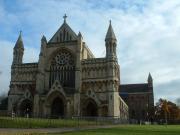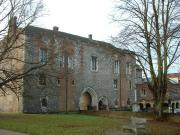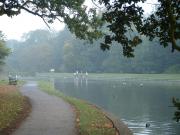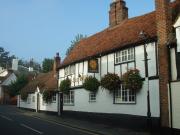St. Albans is the oldest town in Hertfordshire and despite being only 20 miles from London it is often overlooked. The City has been involved in the signing of the Magna Carta, the War of the Roses and the English Civil War and has many historical sites
|
 |
 |
 |
 |
 |
 |
 |
 |
The Cathedral and Abbey Church of Saint Alban
 |
 |
It is thought that it first appeared as a Celtic Iron Age settlement called Verlamion at the end of the first century BC, probably taking its name from the nearby River Ver. Around AD 50, after the Roman conquest of Britain, it became Verulamium and eventually developed into the third largest town in Roman Britain, despite being largely destroyed during the revolt of Boudicca in AD 60.
At some stage during the 3rd Century an event occurred that would eventually give St Albans its name and would also provide England with its first Christian Martyr. A resident of Verulamium named Alban sheltered a Christian priest named Amphibalus in his home and was converted to Christianity by him. When the Roman soldiers came looking for the priest, Alban exchanged cloaks with him and was arrested as the priest escaped. When he was found out Alban refused to denounce his new Christian faith and was beheaded on the spot where St Albans Cathedral now stands.
Several legends are associated with Alban's beheading. One of these is that on his way to the execution, Alban had to cross a river, but as the bridge was blocked he parted the waters and walked through. His executioner was so amazed at this feat that he converted to Christianity on the spot, and refused to kill Alban. Another executioner was however found and it is said that his eyes dropped out of his head when he beheaded Alban.
During the 5th Century, after the Roman army had departed, Verulamium declined and eventually fell into decay. It wasn't until 793 AD that an Abbey appeared on the spot of Alban's execution and over the ensuing years a Saxon settlement grew up around it, much of which was built using the remains of the Roman Verulamium. By the time of the Doomsday Book in 1086 St Albans was recorded as having a population of 500.
|
|
| Favourite spots: |
It soon became a town of great significance and was one of the five chosen by the barons and clergy in 1213 for the drafting of the Magna Carta. St. Albans also played its part in the Peasant's revolt of 1381 when the townspeople were in dispute with the Abbot over milling rights and a desire to have more control of their own affairs. The Monastery Gateway and Clock Tower symbolise the conflict between monastery and town at the time. The Monastery and the Abbey were surrounded by walls to keep out the townspeople and stop them stealing the livestock. The Clock Tower was built between 1403 and 1412 by the people as a symbol of their independence from the church. This conflict continued until the dissolution of the monasteries in 1529.
In 1455 the First Battle of St Albans was said to have been what started the War of the Roses. The Lancastrian army led by King Henry VI occupied the town but the Duke of Warwick and his Yorkists invaded and a large battle took place in the town.
|
|
| What's really great: |
St Albans sided with parliament during the English Civil War and in 1643 the High Sheriff of Hertfordshire was arrested by Cromwell after reading a royal proclamation from the steps of the Eleanor Cross outside the Clock Tower. It wasn't until 1877 that St Albans received a royal charter allowing it to become a City and giving the Abbey Cathedral status. Its official name is now The Cathedral and Abbey Church of Saint Alban.
Present day St Albans has become a popular commuter town but also has great interest for the visitor with much of the area around the Abbey and Market Place retaining its medieval buildings dating from the 15th Century. The old Clock Tower stands as the focal point at the main crossroads between St. Peter's St and the High Street. A market is held every other Sunday in St. Peter's St. and walking tours of the City are available during the summer months.
|
|
| Sights: |
 |
 |
 |
 |
 |
 |
 |
 |
The Great Gateway of the Monastery
 |
 |
The Cathedral and Abbey Church of Saint Alban has a magnificent interior that includes the recently restored Shrine of St Alban, England’s first Christian martyr, and a wonderful Nave. Free guided tours are available twice daily but groups should book in advance. There is a bookstall, gift shop, cafe and information desk in the Chapter House which is the main visitors entrance. The visitor is well catered for and it is well worth having a look around.
Nearby is the Great Gateway of the Monastery which dates back to around 1360. The third printing press in England is said to have been housed here in 1479. Once used as a prison it is now part of St Albans school.
|
|
| Accommodations: |
The Lower Red Lion is a 17th century coaching inn that is now one of the best real ale pubs in St. Albans. Regular beer festivals are held in the car park at the back and it is a handy place to stay during the main St. Albans festival or for visiting this historic town. They have seven rooms, singles, doubles, some en suite at reasonable prices. It is located in the picturesque Fishpool Street close to the Abbey, and the exposed beams and creaking floorboards are a reminder of its past and the fact that little has changed over the years.
|
|
| Nightlife: |
 |
 |
 |
 |
 |
 |
 |
 |
Verulamium Lake in the park
 |
 |
One of my favourite things to do when in St. Albans is to have a walk around the picturesque Verulamium Park. It has a large lake with the River Ver running alongside it and both are home to various wildlife. Here you will also find the Verulamium Museum and some interesting remnants of the Roman wall that once enclosed the town.
Back in the town centre the Clock Tower is a mediaeval belfry containing a large curfew bell. Next to it on French Row is the old Fleur De Lys Inn where King John of France was detained in 1356. Also near this spot stood the Eleanor Cross marking the place where Queen Eleanor’s body rested for a night on its way to Westminster in 1290.
|
|
| Hangouts: |
St. Albans is also famous for being the birthplace of the Campaign for Real Ale (CAMRA) back in 1972. The first ever meeting of CAMRA was held in the Farriers Arms in Lower Dagnall St and now it has its headquarters in Hatfield Road. As a consequence St Albans has many pubs that are renowned for their real ale. As well as the Lower Red Lion mentioned above there is the White Hart Tap, the historic Six Bells in the St. Michael's area and the Farmers Boy, which is also home to the Veralum Brewery.
|
|
| Restaurants: |
The Peahen at the top of Holywell Hill is an old McMullens pub that has now been turned into a gastro pub. Two cask beer pumps remain, one with McMullens County and the other possibly a guest. Prices aren’t cheap but it is a decent place and I would recommend a visit if you want to eat and don't fancy the standard Wetherspoons fare across the road.
The Farmers Boy pub on London Road has a good menu and I had one of the largest plates of steak pie and chips there a while ago. Zizzi restaurant next to the Clock Tower looks to be a child friendly place judging by the number of families queuing outside the last time I was there.
|
|
| Other recommendations: |
 |
 |
 |
 |
 |
 |
 |
 |
The Six Bells in St. Michael's Village
 |
 |
For an interesting walk through olde worlde St. Albans, seek out Fishpool Street. From the Clock Tower turn right down the High St. Follow the road to the left of the Tudor Tavern and you will see the Cathedral on your left. Continue down past the school and into Fishpool St. which gets it's name from a large fishpond located nearby in mediaeval times. It is a residential area that is a mix of old and older properties, stepped entrances, wrought iron door knockers & boot scrapers, old gas lamps, cobbled pathways and ivy clad walls. Follow the winding road for more gems and take note of the high pavements, ideal for alighting horse drawn carriages but not for the cars of today.
Further on you will see St Michael's Manor, which is now a luxury hotel, and at the bottom are two pubs. Follow the road round to the left and over the bridge and you will find St. Michael's village with two lovely old pubs including the historic Six Bells. There is also an entrance to the park opposite.
|
|
Published on Saturday April 8th, 2006
|
|
 Publish on Facebook
Publish on Facebook
|
Sun, Jan 14 2007 - 02:19 PM
 by mrscanada
| I enjoyed reading your 3 reports on the UK |
Tue, Apr 18 2006 - 11:15 AM
 by magsalex by magsalex
| Just to show that we do not have to travel thousands of miles to find a location on which to report! Very informative. |
Mon, Apr 10 2006 - 08:14 AM
 by sajjanka by sajjanka
Mon, Apr 10 2006 - 05:21 AM
 by bear495 by bear495
This is a nice report. Since I do not recognize the name, I presume this is your first report with Globo. Well done!
Russ
|
Sun, Apr 09 2006 - 10:33 AM
 by ragnvaeig by ragnvaeig
| The monastery looks great for photo ops. Will have to try a pub crawl here next time I'm in Hertfordshire. |
Sun, Apr 09 2006 - 06:12 AM
 by ravinderkumarsi by ravinderkumarsi
Sat, Apr 08 2006 - 06:49 PM
 by gloriajames by gloriajames
hiya clive
well done! another wonderful read. keep the good work flowing!!! |
Sat, Apr 08 2006 - 02:18 PM
 by jorgesanchez by jorgesanchez
Sat, Apr 08 2006 - 11:48 AM
 by eirekay by eirekay
| I really enjoyed the historical details~Nicely Done! |
Sat, Apr 08 2006 - 07:24 AM
 by bootlegga by bootlegga
| An interesting read. Keep 'em coming! |
Sat, Apr 08 2006 - 07:12 AM
 by isaacmolina by isaacmolina
| You are improving your skill to write good reports! |
Sat, Apr 08 2006 - 05:24 AM
 by mistybleu by mistybleu
Clive,
This is another great report, and an enjoy to read. |
Sat, Apr 08 2006 - 05:08 AM
 by marianne by marianne
Clive,
Even better than your Gent report. Very informative, a joy to read.
Marianne |
Sat, Apr 08 2006 - 04:27 AM
 by frenchfrog by frenchfrog
| It is more than perfect! well done, lots of info given. |
Sat, Apr 08 2006 - 04:22 AM
 by davidx by davidx
| This is certainly a masterpiece, Clive. I think a good report on this sort of place MUST contain a lot of history - but something else as well. You've got a perfect balance. |
| Information: |
| Login if you are a member, or sign up for a free membership to rate this report and to earn globo points! |
|
| Belgium |
|
|
 |
| United Kingdom |
|
|
|
|
|
|
 |
| United States |
|
|
|

|
